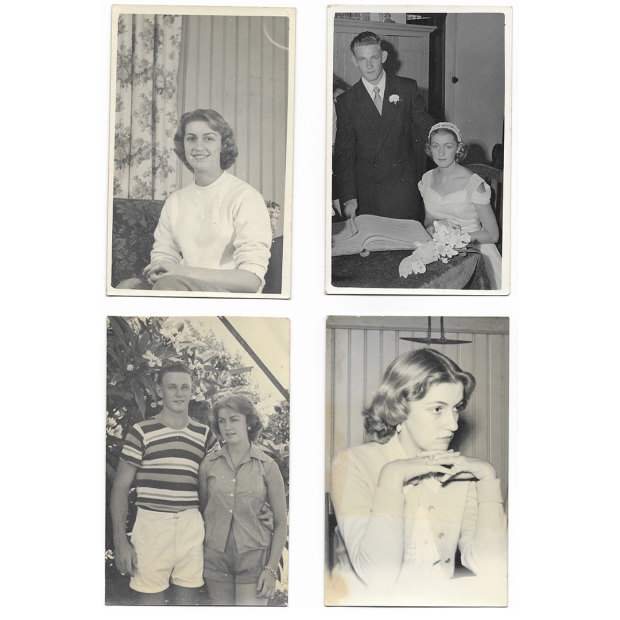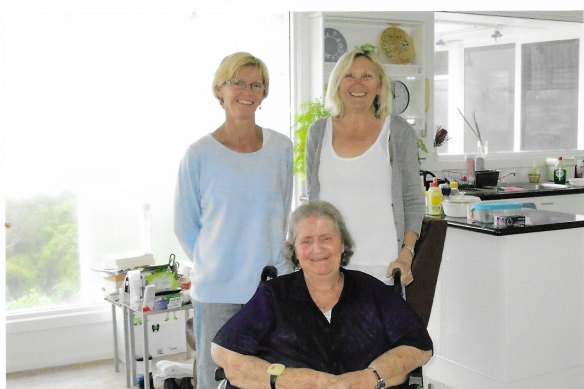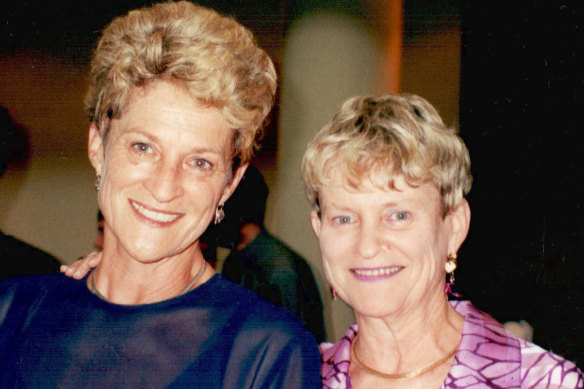This was published 4 months ago
Narelle watched her husband die a painful death, so she chose hers
Hundreds of people in NSW have applied for voluntary assisted dying since it became available in November. For Narelle Onley, whose husband Greg succumbed to prostate cancer, it made perfect sense.

Photos of Narelle and Greg Onley. Narelle Onley died on April 4 by voluntary euthanasia.
Narelle Onley woke just before 6am to the sound of kookaburras outside her hospital window. She listened to her children, grandchildren, and in-laws trickle in through the morning, exchanging stories about her life and how much they would miss her. She watched the clock tick past 11am, then midday, before the doctor and volunteer witness arrived via plane with the injections that would end her life. Then it was time for Onley’s family to say their goodbyes, one by one, in the same way they always had: “Hooroo, Grandma.”
Three breaths and she was gone. At 12.34pm on April 4, Narelle Onley became the first person to end her life through voluntary assisted dying (VAD) at Baringa Private Hospital in Coffs Harbour.
Onley watched her husband succumb slowly to prostate cancer in 2014. When she was diagnosed with endometrial cancer two years ago at the age of 83, she was determined not to put herself or her family through the same.
“It was much kinder for her,” says daughter Kris Gray. “With Dad, we all slept on the floor of his room at the hospital for three days and three nights, waiting for the morphine to kill him … he just kept saying all the time, ‘please turn me off’.”

Narelle Onley with daughters Sue and Kris Gray (right).
For Onley, a straight-shooter who drove tractors and raised four children on a cane farm at Palmer’s Island, it was a simple equation. “On the farm, if we had a sick or injured animal, you just put it out of its misery,” Gray says.
In November, NSW became the last state in Australia to allow terminally ill patients to die with the help of doctors.
In the program’s first three months, 517 people requested access to VAD, and 131 people died, according to the program board’s first report released on Friday. Two-thirds of applicants were from regional NSW.
Gray applied for VAD at her mother’s request in mid-March. From when the first assessing doctor flew up from Sydney right up to her final injection, her medical team checked in at every point to ensure she was aware of her decision and that she could pull out at any time. She struggles to see how the program could be abused.
“In fact, we say ourselves there’s maybe too many safeguards, if anything,” Gray says. “If Mum had slipped into a coma, then it’s off the table.”
People really want to live, I know that’s stating the obvious, but they come to this really because it’s the only option.
Dr Wade Stedman, NSW Voluntary Assisted Dying Implementation Clinical Lead
Critics of voluntary euthanasia have argued palliative care is already a decent and dignified option for those at the end of their lives.
But Dr Wade Stedman, an intensive care specialist charged with leading its implementation in NSW, says the past six months have shown VAD is a complement, rather than an alternative, to palliative care.
“I’ve had to remind many patients who are seeking voluntary assisted dying that you can do a lot better with your palliative care [while they’re applying for VAD],” Stedman says.
In a national survey released by Go Gentle on Thursday, one in five people who applied for VAD said access to trained medical practitioners was a barrier, and others called for restrictions on telehealth consultations to be removed.
Federal independent MP Kate Chaney introduced a private member’s bill in February to change the Commonwealth criminal code to protect doctors consulting terminally ill patients about euthanasia via telehealth.
“There’s not much we can do until that ... goes through,” Stedman says.
In Queensland, a coronial inquest is investigating how an elderly man was able to take a voluntary assisted dying substance intended for someone else. In Victoria, GPs and advocates are fighting to remove a restriction that prevents doctors from raising VAD as an option unless the patient raises it themselves (in NSW, doctors can do so if they also mention other treatment and palliative options at the same time).
Stedman says he believes the law in NSW “gets the balance right” between protecting practitioners and giving patients another option at the end of their life: “People really want to live, I know that’s stating the obvious, but they come to this really because it’s the only option.”
Of the 131 people who died in the three months from November, 40 of those gave themselves the lethal substance, and 91 had the substance administered by a nurse or doctor.
Onley had wanted to die at her home overlooking the ocean at Sapphire Beach, but complications from her cancer meant she spent her last days in hospital.
While the figures don’t specify where people died, Stedman says his experience had been divided “pretty evenly” between the hospital and the home.
“It’s a real privilege for a practitioner when you’re invited into somebody’s home, they’ve got music playing, and they’ve got a family there. It’s pretty moving,” he says. “Sometimes it’s seen as a little bit harder to have it at home, and they’d prefer to have it in hospital. It’s a really personal choice.”
Dr Linda Swan, the chief executive of Go Gentle Australia, said the high number of applicants showed the laws were long overdue. “As awareness grows, we expect more dying people will choose VAD at the end of life,” she says.

Lynne Spender (left) with sister Dale. Both advocated for voluntary assisted dying.
‘I’m going now’
On a warm day in late April, Lynne Spender’s family and closest friends gathered in her Coogee apartment to say goodbye.
The well-known feminist, author and lawyer was sick with late-stage pancreatic cancer and had chosen to end her life. “It was perfect weather, [we had] food, champagne, Lynne was sitting in her chair, and everyone told her how fabulous she was,” says her brother, Graeme.
A few weeks later, on May 31, the 77-year-old got up early, read the news on her iPad, showered and did her hair. Known as “Mama Red” by her five grandchildren, she put on a cream linen dress with a red stripe, red shoes, and a red sleeveless vest. When it was time to leave for her last appointment at Prince of Wales Hospital, she took a final look back at the waves beyond her window, and said: “bye, house”.
“It was the best death you could have,” Graeme Spender says. “The gratitude and happiness [she felt] that she’d stayed in her house until the last day, of being able to look out the window and see her beloved Coogee Beach. She had the strength to say, ‘well, it’s my time. I’m going now’.”
Start the day with a summary of the day’s most important and interesting stories, analysis and insights. Sign up for our Morning Edition newsletter.